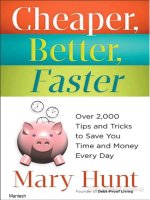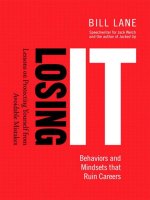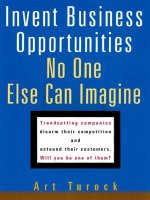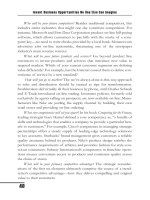Essential tips and shortcuts that no one bothers to tell you about beating the system
Bạn đang xem bản rút gọn của tài liệu. Xem và tải ngay bản đầy đủ của tài liệu tại đây (7.63 MB, 193 trang )
Begin Reading
Table of Contents
About the Author
Copyright Page
Thank you for buying this
Flatiron Books ebook.
To receive special offers, bonus content,
and info on new releases and other great reads,
sign up for our newsletters.
Or visit us online at
us.macmillan.com/newslettersignup
For email updates on the author, click here.
The author and publisher have provided this e-book to you for your personal use only. You may not
make this e-book publicly available in any way. Copyright infringement is against the law. If you
believe the copy of this e-book you are reading infringes on the author’s copyright, please notify
the publisher at: us.macmillanusa.com/piracy.
For the people who’ve
taught me the basics:
Nicki, Kell, Tia, Jeffrey,
Mom and Dad,
and Twitter
Introduction
Every single person on earth would like more money.
If you think you’re the exception—if you think you have too much money—it’s easy to get rid of
some. The rest of us will be happy to help you out there.
The question is: How do you get more money?
Well, you’ve probably heard the old saying “Time is money.” And, yes, that’s true. You can
usually spend time to get money. By working, by learning a new skill, by looking for coins on the
sidewalk.
But here’s the problem with that “Time is money” thing: Time is also limited! You can’t snap
your fingers and have more of that, either.
So that’s just great: We’d like more money, but to get it, we have to spend something else we
don’t have enough of?
You know what else is money, though? Information. If you know certain things, you can get more
money without spending time.
As it turns out, the world is filled with little bits of information that can save you money or make
you money. There’s hardly a single area of life that doesn’t harbor money-saving secrets. Cars,
homes, hotels, planes, restaurants, clothing, hospitals, credit cards, insurance, taxes, movies … If you
knew the ins and outs of every industry, you’d be a money genius.
You can probably see where all of this is going: to this book. Its purpose is to hand those secrets
to you on a silver platter, so you don’t have to scrounge for that precious information yourself. I guess
you could say this book is designed to save you time and money.
The birth of this book
I’ve spent most of my career writing about technology and science. Why am I suddenly writing a
book about money?
The answer is simple: I have a character flaw. I cannot stand things that are inefficient, sluggish,
or poorly designed. My brain spends its spare cycles silently finding loopholes, shortcuts, and better
ways in every corner of life. I pick up “life hacks” the way another middle-aged man might memorize
baseball stats.
When I see someone doing something the long way, I can’t keep my mouth shut. I step forward,
invading the privacy of total strangers, and demonstrate the better way. That’s just the kind of helpful
guy I am.
On one hand, this trait subjects me to the mockery of my wife and kids, who call me “Mr.
Shortcut” (and not with the admiring tone you might expect). I often marvel that, for example, in 2016,
we’re still fastening our sneakers and running shoes using the ancient and clumsy tying-shoelaces
method; my kids roll their eyes.
On the other hand, when I put together a book of technology shortcuts (the first Pogue’s Basics
book), I struck a chord. Apparently a lot of people feel overwhelmed by the featuritis of today’s
electronics.
I followed that with a second book, Pogue’s Basics: Life. This time, I broadened my scope
beyond technology—to everyday life. Traveling, cooking, clothing, shopping, driving, staying healthy.
And now, in your hands, you hold the inevitable Sequel to the Sequel.
I’m particularly proud of this baby. I’ve been a consumer advocate my entire life, constantly on
the lookout for scams, overpricing, and psychological manipulations. I share my insights with anyone
who’ll listen. For me, the opportunity to lay them bare to a wider audience is pure gold.
I also asked my Twitter followers to share with me their own hard-won money-saving tips. You’ll
find some of their contributions in these pages, too, credited with their names italicized. (I also sent
each contributor a signed copy of this book.)
What’s not in this book
Just to get your expectations aligned: There are plenty of money tips you won’t find in these
pages. Here, for example, are some of the categories this book does not contain:
• The painfully obvious tips. You know: Set aside some money for a rainy day. Cook at home instead of eating out. Quit smoking
and drinking. Go to free days at museums.
Use the public library. Exercise regularly to save thousands in health costs over your lifetime.
That’s all good stuff; they’re just not really tips.
• Time-for-money swaps. We’ve sort of covered this already, but just to make it painfully clear: You won’t find recipes for making
your own toothpaste at home, growing your own crops, or ironing and reusing paper towels. All of those things do save you money,
but at a terrible time expense.
• Personal sacrifices. It’s also possible to save money by giving up comforts. You could buy a smaller house, drive a smaller car,
eat smaller meals. You could bike 500 miles instead of buying a plane ticket. You could dry your clothes on a line. You could shift
your sleep schedule so that you rise and set with the sun instead of paying for electricity to run lights.
And if you’re a guy, you could stop shaving. Pretty soon you’d look like Professor Dumbledore, but think of the savings in razors
and shaving cream!
(One tipster actually suggests that you peel apart two-ply toilet paper and use only one layer at a time, thereby making each roll last
twice as long. Sorry, no.)
If you’re among those who have managed to make your life footprint smaller this way, I salute you! You’re a person of tremendous
self-discipline and enlightened thinking.
But I’m after something more ambitious: making your financial impact smaller without shrinking your lifestyle.
• Unethical tips. The Internet teems with suggestions in the category that might best be titled “Abusing the System.” You know:
Help yourself to ketchup and mustard packets from cafeterias to save on store-bought condiments. Fill up on free dinner rolls at a
restaurant, and then order only a cup of soup. Buy one movie ticket and then sneak into film after film all day. Tell your hotel that
it’s a birthday or anniversary so you get a free goody.
• Investment tips. Of course, the stock market is one of history’s greatest money-making engines. But not only is investing a
massive topic that professionals study for decades; it’s also not surefire. Here, therefore, is this book’s entire discussion of
investment advice:
Buy low, sell high.
What is in this book
What you will find in this book: ingenious, mostly non-obvious suggestions for saving and making
money that rely on information. They let you know about quirks in the system. They don’t require big
time commitments, and they don’t require you to make big changes to your lifestyle.
For example:
• If you know the secret, you can buy a $100 iTunes or Amazon gift card for $85. It’s like free money.
• If you’re going to be away from home for a couple of months, you can suspend your cable TV and Internet services. You can
put them on “vacation hold,” which means you won’t pay for the service you’re not using while you’re away.
• Service stations, oil-change shops, and your father all may insist that you should change your car’s oil every 3,000 miles. In fact,
though, that’s a myth that needs to die. Your car’s manual (or Change Oil light) tells you the actual recommended oil-change
frequency—which is between 7,500 and 15,000 miles.
So that’s what’s in the book: clever tricks that save you money—or make you money—on planes,
hotels, groceries, taxes, clothing, cars, TV service, tires, Internet access, electronics, bathroom
supplies, and much more.
A few paragraphs about psychology
To really become great with money, you need more than a sense of economics. You also need an
awareness of psychology—because, basically, money makes us crazy.
We pride ourselves on being rational, on being the animal most capable of reason—and yet we
fall into psychological money traps every day. One study after another shows that our idea of the
value of a dollar swings wildly depending on the circumstances. For example:
• We’re absurdly swayed by comparison. Would you rather take a $50,000-a-year job at a company where your colleagues are
paid half as much or a $100,000-a-year job where your colleagues make twice as much?
If you were rational, you’d take the job that paid you the most: $100,000.
But most people offered this choice say they’d prefer the $50,000 job—because they can’t stand the idea of earning less than their
peers.
In other words, we tend to shop for things relatively, rather than assessing each offering’s value independently. That effect is even
more powerful when it comes to purchases whose value is hard to measure—like homes, paintings, or bottles of wine.
Sellers take advantage of this all the time. If wine-store managers want to boost sales of their $18 bottles, they put $8 and $80
bottles on either side. Most people will instinctively reach for the $18 bottle; compared with $80, that seems like a terrific deal.
• We’re helpless at comprehending big numbers. Our brains are trained to understand things through perceiving them. And we
perceive small numbers all the time. How many people are coming to dinner? How many cupcakes will we need for the party?
How many bedrooms does the house have?
Our experience is built on small numbers, so our ability to understand big ones is severely challenged. You can easily picture five
soccer balls. But can you picture 500 of them? By the time you get to really huge numbers—a $19 trillion national debt, for example
—all you can do is say, “Gee, that’s a really big number.”
Recognizing this blind spot in your own brain can help you make smarter decisions with your money.
• Decision-making is exhausting. Economist Daniel McFadden has written about many of the ways that commonsense laws of
economics break down when the human brain gets involved. He points out, for example, that making choices is tiring. That’s why
grocery stores put candy in the checkout lanes: After a lot of decision-making in the aisles, your brain is fried at the finish line and
doesn’t put up much of a fuss.
• “Free” blows our decision-making to smithereens. Behavioral economist Dan Ariely once ran a fascinating experiment: He
set up a stand in a store where shoppers could buy either a Lindt chocolate truffle for 26 cents or a Hershey’s Kiss for a penny.
The result: identical sales.
The next day, he dropped each price by a penny. The truffle was now 25 cents, and the Hershey’s Kiss was free. Suddenly, 90
percent of shoppers chose the free Kiss, even though the relative price difference (25 cents) hadn’t changed. We hear “free,” and
our normal judgment goes out the window.
• Losing money affects us twice as much as gaining it. Princeton professor Daniel Kahneman won the Nobel Prize in Economics
for demonstrating some ways that money makes us irrational.
For example, he identified loss aversion, in which we fear losing money twice as much as we like getting it. Most people
wouldn’t participate in a coin toss where they’d win or lose $1,000. Most people agree to play only if the prize for winning is at least
twice as great as the penalty for losing ($2,000 if you win, $1,000 if you lose).
• The base amount confuses us. Happiness researcher Dan Gilbert poses a fascinating thought experiment: Suppose you could buy
a car stereo at a dealer near your house for $200, but you could drive across town and get it for $100. Would you make the drive?
Most people would.
But what if you were buying a car? If a dealer near you offered it for $31,000, would you drive across town to get it for $30,900?
Most people wouldn’t bother. It’s a 0.3 percent savings—who cares?
Yet it’s still a savings of $100 in each example. Why should our decision be different?
• We’re terrible planners. We humans are awful at planning ahead. We wait until the night before the exam to study. We don’t
make small diet or exercise changes that will add years to our lives. We keep harvesting more fish than nature can replace, even
though we know we’re depleting the oceans for our descendants.
If we were purely rational creatures, we would make decisions now that would benefit us the most later. But we don’t, and it
affects our financial lives all the time. We keep buying regular lightbulbs, which need replacing every year, for $1 each—even
though an $8 LED bulb will last 30 years. We sign up for cable TV plans because the first year of service is super cheap—and
barely even look at what the price will be for the rest of our lives. We don’t save for retirement.
If you were Mr. Spock from Star Trek, none of these effects would sway you. But you’re not, and
they probably do.
Now that you’re aware of them, though, you can start noticing when they’re at play—and maybe
even resist them.
All prices are made up
When Banana Republic has a “40% Off Everything” sale, do you think they’re going to lose
money on every garment they sell? No, of course not. The existence of that sale just proves that their
usual markup is more than 40 percent.
When a cardboard bucket of popcorn at the movie theater costs $8.50, do you think it’s some
special kind of corn that’s fertilized with gold and watered with unicorn tears? No; it’s the same
popcorn you could make at home for 90 cents.
The point, of course, is that in a capitalist system, every price, for every product and service, is
arbitrary.
Yes, of course prices are affected by supply and demand, the convenience factor, market forces,
regulations, and costs of doing business. But in the end, everyone who sells everything has to make up
a price, usually with profit built in.
And in many situations, there’s some wiggle room—and that’s the secret behind many of the tips
in this book.
The ballpark savings
After each tip on these pages, you’ll see an indication of how much money that technique is worth.
The author kindly requests that you spare him the class-action lawsuits; the “savings ballpark” is
an extremely rough estimate, intended to help you gauge the general worthiness of a tip. It steers you
not to an exact figure, but maybe to the correct power of 10. You’ll know if a tip can save you, say,
$30, $300, or $3,000.
Let’s consider the tip called “Don’t pay for cable while you’re away” here. The savings ballpark
for that tip is $285 a year. Where does that number come from?
Well, the average U.S. household cable TV bill is $100 a month. Of course, bills vary widely, but
that’s the average.
You might go away for a month and save $100. Or you might be a “snowbird,” spending the
winter months in Florida, and save $600 a year.
So the savings ballpark for that tip is based on a savings of $300—right around the middle. Not
the maximum possible savings—only a reasonable, typical figure. (Turning on the vacation hold itself
costs $5 a month, so that’s where the last $15 goes.)
In general, then, the savings ballpark figures give you an estimate of each tip’s typical value. (The
total value of all the tricks in this book comes to just over $61,000. Put another way, buying this book
might be one of the best financial tips of all!)
Chapter 1:
Shopping Hacks
Here’s the frustrating thing about money: As soon as you’ve earned some, the universe gangs up on
you and demands that you spend it. Everywhere you turn, there’s something else to pay for.
Fortunately, for every avenue there is to spend money, there’s a loophole for spending less of it.
When to buy stuff
Prices fluctuate all the time. Supply, demand, the price of raw materials, the price of gas, location, the
economy—it all affects product pricing.
You can’t do much about any of that.
What you can do, though, is control when you shop. In certain industries, the prices for products
always drop at certain times of year, like clockwork.
Actually, what’s a little nonsensical is that there are usually two times for big price dips. First,
there’s the time when demand is highest (sales on toys before Christmas, TVs before the Super
Bowl). Second, there’s the time when demand is lowest (sales on candy after Halloween, bathing
suits after swimming season).
Here’s your master cheat sheet:
• Bathing suits. What store wants shelves full of swimwear that’s no longer selling? Prices are lowest for the year in August, as the
swimming season ends.
• Bicycles. New models roll out in September and October. That, therefore, is a great time to find sales on last year’s bikes.
• Cameras. New models usually debut in February, so you can count on big discounts on last year’s models on Presidents’ Day
weekend.
• Camping gear. Giant price cuts arrive in August; the summer’s over, and so is demand for this stuff. Look for another rash of
sales in October, too.
• Candy. Right after Halloween, every store and its brother slash prices to unload all the unsold candy.
• Car parts and service. April is National Car Care Month, so you may spot special sales that time of year.
• Cars. Many car companies roll out next year’s car models in the fall, so you can get fantastic deals on the current year’s cars
around September.
• Chocolate. The fancy stuff goes on deep discount right after Valentine’s Day (shocker).
• Clothing. In general, clothing for each season goes on sale a couple of months before the next season begins. In February, for
example, they put winter clothing on sale for 50 to 70 percent off, to make room for the incoming warm-weather stuff.
Similarly, spring clothing goes on sale in May, to make room for summer items; summer clothing’s price drops in August; and, of
course, discounts on fall clothes emerge around November.
• Computers go on sale in September, once the back-to-school rush is over. There are more big discounts in November, on Black
Friday and Cyber Monday.
• Cookware. As graduation/wedding season approaches, you can find good deals on kitchen stuff in April and May (especially
Memorial Day weekend).
• Cruises. Sales on sailings usually arrive in January and February, when people are booking their spring break and summer cruises.
In late October, there’s another round of sales—both for people planning holiday cruises and for the cruise lines to unload cruise
cabins that aren’t selling well.
• Electronics. In late November, Black Friday and Cyber Monday have taken on mythic proportions in the gadget world. Every
category of gadget goes on sale: TVs, laptops, phones, tablets, cameras, and so on. Every store and online retailer fights for
headlines, and the winner is you.
• Fitness equipment. January, after the holidays and while New Year’s resolutions are still in force. Huge deals, from 30 to 70
percent off.
• Furniture. New models arrive every February and August, so the best deals (on outgoing models) are available in January and
July. Also look for big sales in November, on Black Friday and Cyber Monday. Office furniture often goes on sale in May and
October.
• Grills. The big rush to buy these is, of course, before July 4—so the prices drop right afterward. Prices crash again in October, as
the weather gets cold.
• Gym memberships. The best deals, logically enough, sprout in June; that’s when demand is lowest, as people head outdoors for
physical activity.
• Holiday decorations. As you’d guess, prices crash right after each holiday. Buy Halloween decorations right after Halloween,
Christmas decorations right after Christmas, and so on.
• Home improvement. Home Depot has its own special Spring Black Friday sale every April.
• Jewelry. Scout for deals in July, when there are no gift-giving holidays for miles to boost stores’ sales.
• Laptops. Shop in June or during the back-to-school frenzy in August.
• Lawn mowers. They go on sale in August and September, when nobody needs them anymore because winter is coming.
• Linens. Look for the “white sales” in January.
• Luggage. New styles appear around March, in readiness for the summer travel season—so you can snap up great deals on last
year’s suitcases. In August, another round of price cuts settles in, since people are pretty much finished with their summer travels.
• Mattresses. The entire industry blows out last year’s models over Memorial Day, so watch for crazy sales in May. More sales
around the July 4 and Labor Day weekends.
• Office furniture. May.
• School supplies. August, of course. Back to school sales!
• Ski stuff. The big sales are usually in March, since nobody’s buying gear for that winter anymore.
• Sneakers. You can find delicious deals as high as 50 percent off in April, as shoe stores try to shoe you up and shoo you outdoors.
• Tools. Shop in July, since Father’s Day is now over.
• Toys. Are you kidding? January, right after the holidays. Everything’s marked down. (Then again, you may also find some big sales
before the holidays, especially on Black Friday and Cyber Monday.)
• TVs. February, to make room for the new models and to accommodate the Super Bowl frenzy.
• Wedding dresses. Nobody’s buying wedding stuff in November and December, so that’s when the bridal shops mark down their
wares to make room for the new year’s designs.
Savings ballpark: $855 a year
$855 = 5 percent savings on $17,100, the annual U.S. family spending on clothing, entertainment, and other consumer
goods
Discounts on everything: RetailMeNot
If you don’t visit RetailMeNot.com before you buy anything, you’re crazy.
This site is a massive collection of coupons—both printable ones to use at physical stores and
coupon codes to use when you buy things online. (Millions of fans find these deals and submit them to
the site.)
You just search for the store you’re shopping in or the thing you’re about to buy. You’d be amazed
at how many times out of 100 there’s a discount waiting for you.
A huge collection of online and real-world shops, restaurants, and services offer coupons and
discount codes here.
A few examples:
• Babies. Babies “R” Us, Diapers.com, Pampers.
• Clothes. Dressbarn, OshKosh B’gosh, Abercrombie & Fitch, Disney Store, Banana Republic, Ralph Lauren, Hanes, Unde
Armour, Forever 21, L.L.Bean, Garnet Hill, The Limited, Saks Fifth Avenue, Victoria’s Secret, Old Navy, Aéropostale, American
Eagle Outfitters, H&M, Gap, Lands’ End, Sports Authority, Lane Bryant, Ashley Stewart.
• Department stores. Macy’s, Amazon, Target, Sears, Bed Bath & Beyond, Kmart, Nordstrom, Lord & Taylor, Costco.
• Drugstores/health. CVS, Drugstore.com, GNC, Walgreens.
• Electronics. Best Buy, Apple Store, Verizon, HP, Newegg, Netflix, Audible.
• Food (takeout). GrubHub, Dunkin’ Donuts, Seamless, Starbucks.
• Gifts. Edible Arrangements, FTD, 1-800-Flowers.com, ProFlowers, Teleflora.
• Home. Home Depot, Lowe’s, Pottery Barn, Ace Hardware. (Also PetSmart and Petco.)
• Office. Staples, Office Depot, OfficeMax.
• Restaurants. Pizza Hut, Subway, Ruby Tuesday, Domino’s, Olive Garden, Boston Market, Outback Steakhouse, Denny’s, Burger
King, Einstein Bros. Bagels, Chili’s, Restaurant.com.
• Shoes. Payless, Foot Locker, Famous Footwear, Nike, UGG Australia, Shoes.com, Adidas, Converse.
• Tickets. Ticketmaster, Fandango.
• Travel. Airbnb, Hotels.com, Budget Car Rental, Avis, Enterprise, Hertz, SuperShuttle, Travelocity, Expedia, Priceline, Southwest,
Frontier Airlines, Uber, Spirit Airlines, Hotwire, Dollar Rent a Car, CheapOair, Amtrak, Alamo Rent A Car, Park ’N Fly, Emirates
airline, CheapTickets, Thrifty Car Rental.
The trick here is to remember to visit RetailMeNot whenever you’re about to buy something.
There’s an excellent free RetailMeNot app for your smartphone, too. When you’re actually out in
Shopping Land, about to make a purchase, you can check the app to see if this store has coupons
available. The app can also make your phone chirp and vibrate when you’re walking by a store with
coupons available.
Bottom line: RetailMeNot is like free money. You should take it.
Savings ballpark: $600 a year
$600 = An average savings of 15 percent, assuming that you use RetailMeNot on half your purchases (average
consumer expenditures on physical goods: $8,000 annually)
The eight great ways to get cheaper movie tickets
The movie industry got it all wrong. It predicted that if home VCRs and DVDs were allowed to
proliferate, we’d all stop going out to see movies. The entire movie industry would collapse.
Instead, what happened? We go out to see movies more than ever before. Our habit of watching
movies at home turned us into a nation of movie nuts.
Along the way, what was once the ultimate cheap family getaway has become an expensive family
getaway. In big cities, movie tickets are $15 each, popcorn is $8, and soda is $5; add in parking, and
suddenly you’re looking at over a hundred bucks for the family.
Fortunately, if you’re willing to plan ahead, it’s possible to snag discounted entry to the multiplex.
Let us count the ways:
• Harness the power of the group. You can read about Groupon.com here—but one of its most attractive offerings is frequent
deals on discounted Fandango tickets. (Fandango sells movie tickets to every theater near you.) A typical deal might be $16 for a
pair of movie tickets, which saves you about 30 percent.
AAA and AARP memberships get you movie-ticket discounts, too (here and here).
• Sam’s Club, Costco. These membership discount stores (here) sell discounted tickets to local movie theaters. You just have to ask
for them at the customer service desk. You might, for example, snag a 10-ticket book for $85, which represents a discount of 15 to
25 percent, depending on the price of movies where you live. (Movie tickets are much more expensive in big cities than in rural
areas.)
And remember: If you buy your discounted tickets using a cash-back credit card (here), the deal is even sweeter.
• Discounted gift cards. Gift-card exchange sites like GiftCardGranny.com and CardCash.com (here) are teeming with gift
cards to the major theater chains, ready for you to buy for 15 percent off. If you’re a frequent moviegoer, you really must buy
movie cards there and start paying less.
• Matinees. Movies that begin before dinnertime are often sold at “bargain matinee” prices—$6 or $8 instead of $10 or $12, for
example. This offer varies; to find out, call the theater. Or pull up Fandango.com, click the movie showtime you’re eyeing, and
look at the matinee price.
• The unlimited-movie plan. At MoviePass.com, you can sign up for this most unusual program: For $30 a month, you can see
all the movies you want.
There are no blackout dates, and almost all theaters are included. If you see three movies a month, you start coming out ahead. If
you see more than one a week, you save a lot of money. Heck, you can see a movie every day—total price, $1 a ticket!
There’s some fine print: IMAX and 3D movies aren’t included. You have to pay the $30 a month for an entire year, or else pay
early-cancellation fees ($20 to $75, depending on how soon you quit).
Otherwise, though, MoviePass.com is like Netflix for going out to the movies.
• Join the club. Every major theater chain offers its own loyalty program: Regal, AMC, Cinemark, Carmike, Showcase, Bow Tie,
and so on. It’s free to join. The more movies you attend, the more points you get, and you can redeem them for free popcorn,
drinks, and movie tickets.
More to the point, you also get discount offers by email, a free movie ticket on your birthday, and other goodies.
• B e old or young. Movie theaters offer student discounts and senior discounts—and their definitions of “student” and “senior” can
be pretty lax. In some places, over 50 is considered old enough for the discounted senior ticket.
• See advance screenings. Most movies host free advance screenings in big cities—for critics, for bloggers, for building word of
mouth. Yes, we’re talking about free movies before the public gets to go see them.
In the days of yore, the only way you’d get invited was to be on the mailing list of the P R company setting up the screenings. These
days, though, you can register with Gofobo.com (or use its app). Gofobo lets you search for advance screenings near you—and
you get invitations to them.
Two footnotes. First, they want to ensure a full house, so they distribute more passes than they have seats; you’ll be told to arrive
an hour early. (You’ll also be told to leave your cell phone in the car, to ensure that you won’t record the movie illegally.) Second,
you may be alarmed at how much junk email you get once you’ve signed up. For best results, register with Gofobo using a
secondary email address, so that your primary address doesn’t get clogged up.
There are also, of course, free movie showings at schools, libraries, and town summer programs.
And there are “second-run” theaters in most cities, where the movies are a few months old but also
half-price.
Savings ballpark: $115 a year
$115 = 20 percent savings for a family of four, seeing one movie a month at $12 per ticket
The truth about Gap, Banana Republic, and Old Navy
If you wander into one of these popular clothing stores and pay the price on the tag, you’re a sucker.
Plain and simple.
You should never pay full price at Gap, Banana Republic, or Old Navy. A single mother ship
(Gap Inc.) runs all three chains, and they all follow the same fascinating business model: They price
the clothes higher than you might expect—but then they shower the world with sales and discounts
and deals. All the time. If you time your visits, you can walk away with great clothing at much lower
prices.
Here are some of the techniques. (Most of them work identically for Gap and Banana Republic.
Old Navy’s savings mechanisms are similar, but the percentages may differ.)
• 40-percent-off-everything sales. Gap, Banana Republic, and Old Navy run 40-percent-off sales every couple of months, often
tied to holidays. The sales usually run for several days.
The crazy part is that some items are already on sale when the 40-percent-off sale rolls around. That is, you can get 40 percent off
the sale price.
So how do you know when one of these sales is on? Visit the website (Gap.com, BananaRepublic.com, or OldNavy.com); you
won’t be able to miss the banner advertising the sale.
Or, if you’re willing to surrender your email address, you can sign up for these stores’ email newsletters, right there on their
websites. They’ll email you when the sales are on. As a bonus, the mere act of signing up for that newsletter usually gets you a
coupon for 15 or 20 percent off.
• 20 percent off anything. When you buy something at one of these three stores, along with your receipt, you generally get a little
slip of paper inviting you to take an online survey. (Gap’s survey, for example, is at survey4gap.com.)
The survey takes about 15 minutes. When you finish, you’ll be given a code to write on the receipt—worth 20 percent off anything
on your next Gap or Banana visit. (Old Navy’s code is worth 10 percent instead.)
• 10, 15, 40, or 50 percent off anything with the store credit card. When you buy anything
at Gap/Banana/Navy, the cashier will probably invite you to sign up for the store’s credit card.
If you ever expect to shop at any of these stores again—or even if not—go right ahead. (You
can use the same card for discounts at all three chains.) Card ownership works like discount
magic:
First, you get 15 percent off whatever you’re about to buy right now.
Second, you get 10 percent off anything you buy in the next two months.
Third, you get 10 percent off everything you buy on any Tuesday at Gap.
Fourth, you’ll get frequent emails offering you discount offers exclusively for cardholders—
usually 40 percent off everything. (In recent years, cardholders were invited to get 50 percent
off during the week leading up to Black Friday in November.)
Fifth, you get $5 back on every $100 you spend.
Finally, if you spend at least $800 a year, you get Silver status: free shipping on everything you order online, with no minimum order.
Note: This store-credit-card business is a fantastic idea if you pay your whole credit card bill each month. If you don’t, you’ll be
slapped with very high interest rates and late fees. You’ve been warned.
• 50 percent off anything, anytime. Work at the store. Employees get half off everything.
Savings ballpark: $270 a year per person
$270 = 30 percent off, shopping at Gap Inc. stores for half of the average American’s $1,800 in apparel spending
Meet coupons, 21st-century style
Back in the day, our moms clipped coupons from the newspaper. Depending on how serious they
were about it, they wound up saving a lot of money over the years.
Eventually, many people quit clipping paper coupons. The time-money trade-off just wasn’t good
enough. Sure, you could save 50 cents on a bottle of window cleaner—but the time it took to pore
through newspaper supplements, clip the coupon, keep it organized, and remember to use it was
probably worth more than 50 cents.
But what if the Internet could change that time-money value proposition? What if that couponclipping session took only a minute and involved no actual clipping? You’d check it out, right? You
wouldn’t want to leave money on the table every time you went shopping, right?
The Internet is full of sites that round up thousands of coupons in one handy, searchable place.
They include Coupons.com (the biggest one), RedPlum.com, and SmartSource.com. On these sites,
you scroll through the hundreds of available coupons or just do a search for specific products. When
you see one that looks good, one click (on a Print or Clip button) adds that coupon to your list of
printouts-in-waiting.
When you’re finished browsing, you can print all the rounded-up coupons on a few printer pages,
which you then take to the store.
Savings ballpark: $312 a year
$312 = Three coupons a week, face value of $2 each
Tips from the cult of extreme couponing
It’s possible to take the concept of couponing to an almost unhealthy extreme.
There are people, perhaps even some you know, who spend hours a week playing the coupon
game. They seek out deals so extreme that the couponers actually make money by buying things. They
have four subscriptions to each Sunday newspaper so they’ll have four copies of the really useful
coupons. They carry foot-thick binders full of carefully organized coupons to the store. They speak
jargon like “BOGO” (buy one, get one free), “OYNO” (on your next order), and “Catalina” (the
special printer at the checkout that spews out coupons after your sale is complete).
And they fill their pantries with $5,000 worth of supplies that, in the end, cost them only $300.
It’s called extreme couponing. These people exist. They were even the subject of a TLC TV
series, Extreme Couponing.
You, of course, would never take things that far. You plan to use the information in this book only
to save money on things you intend to buy anyway, and you won’t spend more than a couple of
minutes doing it. Right?
Nonetheless, there’s no shame in knowing some of the extreme couponers’ tricks. They include
these:
• Stacking. Stacking coupons is applying two coupons to the same item so that it winds up costing nearly nothing. Now, you’re not
allowed to use two manufacturer’s coupons on the same item—two Crest toothpaste coupons, for example. But most stores permit
you to use a store coupon and a manufacturer’s coupon on the same item.
• Competitor coupons. Many stores accept coupons issued by other stores. For example, you might be able to use a Target coupon
for some pain reliever at your ShopRite. (Not all stores will do this—you have to ask.)
• Buy by the sale, not by your need. You may not need deodorant right now. But hard-core couponers realize that, sooner or later,
they’ll always have to buy certain staples—paper towels, toilet paper, favorite cereal, ketchup, and of course what they call HBA
(health and beauty aids like shaving cream, soap, dental floss, toothpaste, and shampoo).
So when the deals come, take them, whether you’re currently running low on those items or not. Buy five or six of something if the
deal is good. Stuff them in your pantry or under-sink bathroom cabinet, and enjoy the rosy glow of knowing that you’ve planned
ahead.
Local shops vs. the Internet
It’s a classic dilemma. Should you buy something in a physical store, where you’ll support a local
business, boost the local economy, and get your purchase immediately?
Or should you buy it online, where you can save money?
Often, the decision boils down to how much lower the online price is. If that blender on the shelf
in front of you costs $90 less online, then it might be worth ordering it instead of bringing it home
with you.
That’s the beauty of smartphone apps like RedLaser and ShopSavvy. You aim your phone’s
camera at the bar code on the package—and instantly, the app tells you how much that identical
product would cost if you bought it from an online retailer.
Information is power—so, so much power.
Savings ballpark: $300 a year
$300 = 10 percent savings on $3,000 worth of consumer goods a year
Best Buy vs. the entire Internet
When it comes to electronics, the “Buy it online, or buy in the store?” debate isn’t nearly so difficult.
Best Buy, the national electronics chain, has a price-match guarantee. It promises to match the
price of any product at any rival store within 25 miles.
But who cares about store prices? What you really want is for them to match the prices of online
stores, like Amazon.com or TigerDirect.com!
In fact they will. It’s called the Best Buy Price Match Guarantee, and you’ve got it in writing—on
the Best Buy website.
It works like this:
Find what you want to buy at a local Best Buy. Whip out your smartphone. Search for that item on
all the usual discount online retailers: Amazon.com, Dell.com, HP.com, Newegg.com,
TigerDirect.com, BHPhotoVideo.com (photo and video supplies), or Crutchfield.com (audio and
video for cars, home theaters, and professionals).
Show the lower online price at the store’s customer service desk. Boom: They give you the online
price at the physical store without even blinking.
Savings ballpark: $25 per purchase
$25 = 5 percent savings on a typical $500 appliance
The shameful truth about extended warranties
For many years, Consumer Reports has been tracking product failure rates and extended-warranty
programs. Want to know what they’ve discovered about extended warranties?
They’re a rip-off.
Often, when you buy a new car, phone, microwave, camera, or whatever, you’ll be asked—with
tremendous salesperson encouragement—to pay extra for a longer warranty period. (Why the
enthusiasm? Because the salesperson gets a commission on every extended warranty sold.)
An amazing number of us give in. For example, 40 percent of new-fridge buyers pony up for the
extra warranty. They worry that if something does go wrong, they’ll kick themselves for not having
gotten the warranty when they had the chance.
The truth is, though, that an extended warranty is insurance. Or, rather, it’s a bet—that your
appliance will break outside the original warranty (say 90 days or a year) but inside the extended
warranty period.
But the statistics show that they almost never do. If a new product fails, it’s almost always soon
after purchase, well within the original warranty period.
There are a few situations when the extra coverage is more likely to pay off: when you buy a used
car, or a laptop, or a cell phone—as long as the policy covers everything, including loss and
dropping.
Remember, though, that your credit card may offer extended-warranty coverage automatically.
It’s a common perk for credit cards.
In general, extended warranties are a waste of money.
Savings ballpark: $160 a year
$160 = Extended warranty prices for one major and one minor appliance
An Amazon Prime primer
No book about money would be complete without mentioning Amazon Prime. For better or worse,
there’s nothing quite like it in the world.
When the service began in 2005, Prime membership cost $80 a year. For that, you got free twoday shipping on anything. You broke even if you bought at least 25 things a year.
(Not everything is eligible for Prime delivery, but most things are. A Prime logo lets you know.)
Since that time, Amazon has raised the price to $100 a year (or $11 per month), but has quietly
added a weird, random, but valuable list of perks to membership. Now Prime also gets you all of
this:
• Prime Video is an unlimited streaming movies-and-TV-shows service, almost exactly like Netflix. They’ve got thousands of
movies in the catalog, lots of entire seasons of TV shows, and a few original shows (produced by Amazon). None of it is quite as
good or quite as copious as what Netflix offers, but it’s getting closer. (You can subscribe to Prime Video alone—without all the
other Prime benefits—for $9 a month. Of course, that makes no sense, since that’s $108 a year—more than a full annual Prime
membership.)









